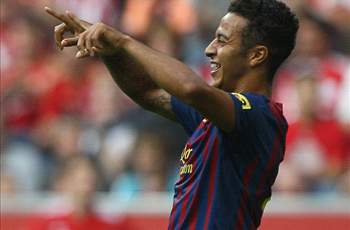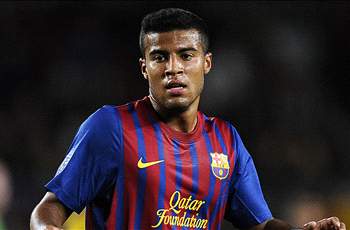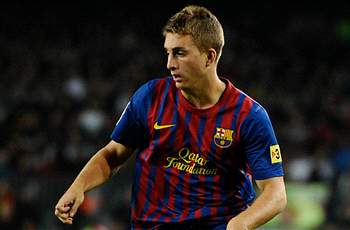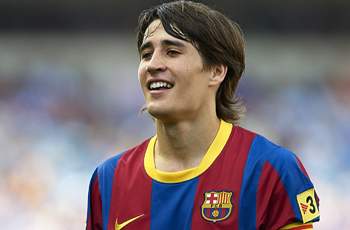While Pep Guardiola plundered Camp Nou's production line to great effect, Tito Vilanova's era looks set to be more reliant on imports
COMMENT
By Graham Ruthven
As Barcelona prepared to face Arsenal in the last 16 of the 2011 Champions League, Pep Guardiola was asked for his opinion on opposition midfielder Jack Wilshere.
“He is lucky,” the Barca coach responded. “Because we have many players in the second team like him. He plays because there is no pressure at his club to win titles.”
At the time Guardiola had a basis on which to form his argument. After all, he had led Barcelona to a treble in his debut season as a top-level coach before conquering Europe for a second time in three years in 2011, defeating Manchester United in the final with a line-up consisting almost entirely of youth academy graduates. Guardiola appeared to have established a fully self-sufficient structure, a system that could almost operate without a figurehead.
Under Guardiola, Sergio Busquets, Thiago Alcantara, Pedro, Bojan Krkic, Isaac Cuenca, Marc Bartra, Martin Montoya and Cristian Tello all made the jump from the club’s youth and B teams to the senior squad. The pipeline of accomplished, technical talent flowing from La Masia to the first team was gushing.
When a jaded Guardiola left the club to take a year sabbatical from the game, debate raged as to what the impact would be on Barcelona and the team’s distinct identity. A year on Tito Vilanova has indeed moved Barca on from the Guardiola era, but has the club’s fabled youth academy taken the hit?
Vilanova’s transfer strategy since taking over from Guardiola suggests his faith in La Masia isn’t as steadfast as his predecessor’s.
Since assuming the head coach role at Camp Nou last summer Vilanova has splurged almost €100 million on Alex Song, Jordi Alba and Neymar. While Guardiola also splashed the cash externally, he would regularly look to plug gaps in his squad by plundering the youth ranks.
By Graham Ruthven
As Barcelona prepared to face Arsenal in the last 16 of the 2011 Champions League, Pep Guardiola was asked for his opinion on opposition midfielder Jack Wilshere.
“He is lucky,” the Barca coach responded. “Because we have many players in the second team like him. He plays because there is no pressure at his club to win titles.”
At the time Guardiola had a basis on which to form his argument. After all, he had led Barcelona to a treble in his debut season as a top-level coach before conquering Europe for a second time in three years in 2011, defeating Manchester United in the final with a line-up consisting almost entirely of youth academy graduates. Guardiola appeared to have established a fully self-sufficient structure, a system that could almost operate without a figurehead.
Under Guardiola, Sergio Busquets, Thiago Alcantara, Pedro, Bojan Krkic, Isaac Cuenca, Marc Bartra, Martin Montoya and Cristian Tello all made the jump from the club’s youth and B teams to the senior squad. The pipeline of accomplished, technical talent flowing from La Masia to the first team was gushing.
When a jaded Guardiola left the club to take a year sabbatical from the game, debate raged as to what the impact would be on Barcelona and the team’s distinct identity. A year on Tito Vilanova has indeed moved Barca on from the Guardiola era, but has the club’s fabled youth academy taken the hit?
Vilanova’s transfer strategy since taking over from Guardiola suggests his faith in La Masia isn’t as steadfast as his predecessor’s.
Since assuming the head coach role at Camp Nou last summer Vilanova has splurged almost €100 million on Alex Song, Jordi Alba and Neymar. While Guardiola also splashed the cash externally, he would regularly look to plug gaps in his squad by plundering the youth ranks.
| LA MASIA REJECTS UNDER TITO VILANOVA | |
| THIAGO ALCANTARA | |
 | The highest profile exit since Tito Vilanova's arrival, Thiago chose to join Pep Guardiola's Bayern Munich on a five-year deal for €20m plus add ons. |
| RAFINHA ALCANTARA | |
 | Rafinha, 20, was loaned out for the 2013-14 season to Celta Vigo the day after his brother Thiago left Camp Nou permanently for the Bavarians. |
| GERARD DEULOFEU | |
 | Believed to be one of Barcelona B's hottest prospects, Vilanova dispatched Deulofeu quickly this summer to Everton on a year-long loan spell. |
| BOJAN KRKIC | |
 | Following his return to Barca after two forgetful years at Roma and AC Milan, the attacker - now 22 - was instantly sent away to Ajax for a 12-month loan. |
| ISAAC CUENCA | |
 | In January, it was Cuenca who made himself at home for the second half of last season at Ajax, though his loan spell was wrecked by a knee injury in March. |
By parting with €57m for Brazilian posterboy Neymar, Vilanova’s transfer activity this summer could be interpreted as desperation. Neymar is not the sort of player Barca needs but the latest generation of La Masia graduates have failed to earn Vilanova’s trust. His signing is a distraction, albeit an extremely exciting one.
The distinction between Barcelona, the bastions of the youth academy conveyer belt, and their Clasico rivals Real Madrid, the pioneers of the Galactico culture, is no longer so obvious.
Furthermore, Vilanova has actually started to dilute La Masia’s existing influence at Barcelona, allowing Thiago to join Bayern Munich and sending promising young players like Gerard Deulofeu and Cuenca out on loan. It’s been suggested that Barca could even be willing to let Cesc Fabregas, the prodigy who returned to the club just two years ago, leave for Manchester United.
In doing so, Vilanova has to some extent made Barcelona more ordinary, belittling the intimidating aura around the Catalan club and La Masia that once seemed so impervious with Guardiola in charge. While Barca were once a force considered to be immortal, now the perpetual productivity of La Masia doesn’t appear so sustainable.
Of course it would be foolish to assume Vilanova is overlooking the next generation of Lionel Messis, Xavis and Andres Iniestas. Those type of players are the exception, rather than the standard, to what La Masia produces. And, in fact, Vilanova actually fielded the first entirely homegrown XI for the first time in the club’s history in a 4-0 win over Levante last November. But the opportunities that were once afforded to talents like Tello, Pedro and Thiago by Guardiola are no longer on offer.
This new approach is most evident in Barcelona’s search for a new centre-back this summer.
Barca’s deficiency in central defence has been clear for a number of seasons but now that Vilanova has publically recognized that flaw he won’t turn to La Masia for a solution. Bartra and Montoya have been dismissed as credible options and, instead, Barcelona have been linked with expensive moves for Marquinhos, Thiago Silva and David Luiz. "We want to sign a centre back," Vilanova said in a press conference earlier this week.
La Masia is the house that built this storied Barcelona side, but were we misled over the true depth of its riches or has Vilanova chosen to ignore what it produces? Either way, the pipeline is no longer flowing as freely.
The distinction between Barcelona, the bastions of the youth academy conveyer belt, and their Clasico rivals Real Madrid, the pioneers of the Galactico culture, is no longer so obvious.
Furthermore, Vilanova has actually started to dilute La Masia’s existing influence at Barcelona, allowing Thiago to join Bayern Munich and sending promising young players like Gerard Deulofeu and Cuenca out on loan. It’s been suggested that Barca could even be willing to let Cesc Fabregas, the prodigy who returned to the club just two years ago, leave for Manchester United.
In doing so, Vilanova has to some extent made Barcelona more ordinary, belittling the intimidating aura around the Catalan club and La Masia that once seemed so impervious with Guardiola in charge. While Barca were once a force considered to be immortal, now the perpetual productivity of La Masia doesn’t appear so sustainable.
Of course it would be foolish to assume Vilanova is overlooking the next generation of Lionel Messis, Xavis and Andres Iniestas. Those type of players are the exception, rather than the standard, to what La Masia produces. And, in fact, Vilanova actually fielded the first entirely homegrown XI for the first time in the club’s history in a 4-0 win over Levante last November. But the opportunities that were once afforded to talents like Tello, Pedro and Thiago by Guardiola are no longer on offer.
This new approach is most evident in Barcelona’s search for a new centre-back this summer.
Barca’s deficiency in central defence has been clear for a number of seasons but now that Vilanova has publically recognized that flaw he won’t turn to La Masia for a solution. Bartra and Montoya have been dismissed as credible options and, instead, Barcelona have been linked with expensive moves for Marquinhos, Thiago Silva and David Luiz. "We want to sign a centre back," Vilanova said in a press conference earlier this week.
La Masia is the house that built this storied Barcelona side, but were we misled over the true depth of its riches or has Vilanova chosen to ignore what it produces? Either way, the pipeline is no longer flowing as freely.











0 commentaires:
Post a Comment